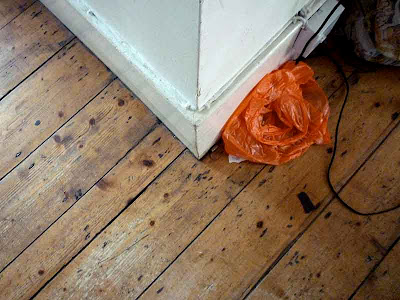
Details from the design for The Pea Stool, an upholstered piano stool commission. Not quite complete, with leaf and other elements to introduce. The image will then be screenprinted onto a similar linen to The Point Chair.
The stool is intended to be seasonal, referring to the time at which it is made. At the moment we are picking peas and the poppies have dropped. A key pictorial step has been to use linework in order to ask Sally, in the embroidery, to describe the twisting, crumpled surface of particularly the decaying petals. To date we have tended to fill areas without acknowledging how various stitches might follow form.
The working step here was to track a deliberate route through direct, unmediated observation and into synthesis of each form. Wanted to use this post to show the route, with stages here that I haven't normally shown. I feel quite challenged by the use of familiar things. With each thing I want to start again and look at it hard enough so that it becomes unfamiliar again. Here I place kindred, made objects next to the pea pod in order to find incremental and useable points between something naturalistic and something synthetic.

Drying the peas (and holding them up against the light) helped to see the full armature, with the sense that in this form the silhouette, the skin, is determined by what is happening within.

The plant itself is complex, moving in many directions, so I picked enough of one to then be able to crudely cut it down to flatland. I've looked before at fractal diagrams of growth and also Munari's lovely book on how to draw a tree but again here wanted to find a sort of 'born yesterday' surprise in how it works.

Botanicals, in their motive to explain all moments and permutations, interest me in the way everything is looking at you (see the upper and lower sides of the leaf revealed through a 'natural' twist). Also the indiscriminate breaking of picture space and ending of a form where it becomes unnecessary.
The poppies are dying and this was important; to capture a phase beyond the optimum. This I know will be ongoing; a kind of phorensic acknowledgment of the non-moment. The time when things are beyond archetype and when they cannot be described as an harmonius whole. Each one goes its own way.
Amongst the screen-drawn-studies, there are elements not used which will be in a subsequent chair. For example, the cone-like form is describing the overnight moment when the petals unfurl themselves out of the head.

These studies are very clean; too clean in their line. But they are this way because of the clarity needed in order to translate well to stitch. It is Sally's stitch which gives the line its life back. The forms do begin by hand (as seen below) and end by hand.
An accompanying activity is to see things which parallel the natural forms and help to tease out how edits and formulae might be applied.
So, sketchbook. Not shown this stage before, perhaps because they are speaking just to me. But I think they are useful to see because all of the spaces between the seen and the synthesized are filled here. This is where the majority of the working-out takes place, whether that be composition (out of sketchbook, scale 1:1) or form.
I waste a lot of paper. I keep it all. Old drawings become useful later on. The drawings themselves have a certain sloppiness because they are purely a means to an end. Sometimes the colour is conscious, often more a case of what is to hand.
The key is a loose, manual thinking taking place. No pressure. Lots of paper. So that surprises can occur.
So these happen before and during the drawings happening on screen, where then they start to inform one another. I'm in Berlin, photographing, analysing the space at Direktorenhaus. Next post will concern the spaces and early ideas.
















2 comments:
This is fantastic! It is great to see the evolution of the design, your process of creativity. I am truly inspired.
greatly enjoy your translations of Pea language, Peter.
-and the mystery of botanical illustrations, yes!
omni-focused ( unlike a photo)
and bathed in the milk of whitespace
parts laid out like votive objects...
Post a Comment